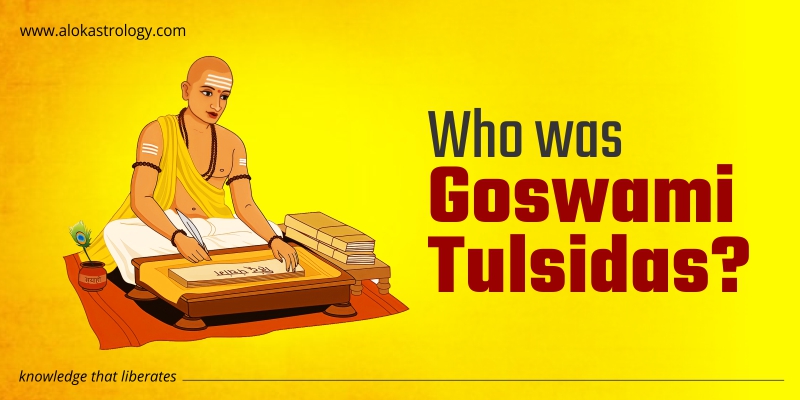Goswami Tulsidas was a famous poet and Hindu saint. He loved Lord Rama, who was the seventh incarnation of Lord Vishnu. During his life, he wrote many texts and books, but Ramcharitmanas, an epic poem about the life of Lord Rama, is what most people remember him for.
Know why is Tulsidas called Goswami? Get an online astrology consultation by the world-renowned Astrologer Mr. Alok Khandelwal.
Tulsidas lived all of his life in Vanarasa and Faizabad. In Vanarasa, there are 88 Ghats. One among them is Tulsighat, a place where Goswami Tulsidas wrote Ramcharitmanas and which is named after him.
Tulsidas was the first to put on Ramlila, a dramatic play about Rama’s life based on the Hindu epic Ramayana. Tulsidas also built the Sankat Mochan Temple in Varanasi, which is a temple for Mahabali Hanuman.
Tulsidas is a highly respected and well-known poet in India and all over the world. So, swami Tulsidas has affected modern education, popular music, art, movies, and TV.
The Sanskrit word “Tulasidasa” is where the word “Tulsidas” comes from. The word “Dasa” means “maid, servant, or slave,” and “Tulasi” is the name of a holy Hindu basil plant that is used to worship Lord Vishnu.
Goswami Tulsidas's life story
The exact date of Tulsidas’s birth is different according to each biographer. Based on Mula Gosain Charita, one group of biographers said that Tulsidas was born in 1554 B.S. On the other hand, a group of biographers led by Sant Tulsi Sahib and Hathras said that the birth year was 1568 Bikram Sambat. Biographers of today and even the Indian government believe that Tulsidas was born in 1554 B.S.
One story about how Tulsidas was born says that he came into the world after a year. He was born with 32 teeth, and a body like a five-year-old, and instead of crying like other babies, he would say “Rama.” So, they called him Rambola. Mula Gosain Charita says that Tulsidas was born in the star to sign Abhuktamla, which means that his parents were in danger. So, on the 4th day after he was born, his parents left him.
A Vaishnava muni named Narharidas took Rambola in when he was five years old and began teaching him. After Virakta Diksha, Rambola changed his name to Tulsidas and began his philosophical journey. He learned Sanskrit grammar, the Vedas, the Vedangas, and Jyotish in the holy place of Vanarasa.
Goswami Tulsidas authored texts, books, poems, and songs throughout his life. Based on the language, the biographers divided the 12 works into 2 groups. They’re;
Awadhi literature
- Ramcharitmanas
Tulsidas wrote this epic poem between 1523 and 1623 B.S. It was one of Tulsidas’s best and earliest works. It is a long poem that tells all of Lord Rama’s stories from Valmiki’s Ramayana. “Ramcharitmanas” means “lake of Lord Rama’s accomplishments.” Ramcharitmanas has been called the “living sum of Indian culture” and “the greatest book of all devotional literature,” among other things.
- Ramlala Nahachhu
It talks about what happened to Lord Rama when he was young and is made up of 20 Awadi verses written in a Sohar metre. In the Hindu ceremony of Nahachhu, a child’s toenails are cut.
- Barvai Ramayan
It has 69 verses written in the Barvai metre. It is a shorter version of Valmiki’s Awadhi Ramayana.
- Parvati Mangal
Also, it means that Devi Parvati got married. It is 162 verse, of which 148 verse is in the Sohar metre whereas 16 verse is in the Harigitika metre. It tells how hard Devi Parvati worked to make Lord Shiva her husband, and how they got married.
- Janaki Mangal
It means that Devi Sita got married. It has 216 stanzas written in both Hamsagati metre (192 stanzas) and Harigitika metre (48 stanzas) (24 stanzas). The story of Lord Rama and Devi Sita’s wedding from the original Ramayana is told in this work by Awadhi.
- Ramagya Prashna
This means finding out what Lord Rama wants. It is an Awadhi work with 343 Dohas that are split into seven books, or kandas.
Braj literature
- Krishna Gitavali, also called Krishnavali, is a collection of songs that people say Lord Krishna wrote. It is made up of 61 songs. 32 hymns show Krishna’s childhood play (Bala Lila) and Ras Lila. The other 27 songs show Krishna and Uddhava talking. The last two lines describe what happened when Draupadi took off her clothes.
- Gitavali is a collection of 328 songs in the Braj language that tell the story of the epic Ramayana.
- Dohavali is a set of 573 verses written in the Braja dialect in the Doha and Sortha styles. It talks about things like being kind, knowing about politics, and the goals of life.
- Vairagya Sandipini is a Braj work with 60 verses that talks about the scenario of Jnana (knowledge, realization), Vairagya, ethical behavior, and a saint’s eminence.
- Vinaya Patrika is a collection of 279 songs. Its name, “Letter of Petition,” comes from what it is. In front of Lord Rama, Sita, Lakshman, Bharat, and Shatrughan, who were the judges, it was authored as a petition against 6 passions: lust, anger, selfishness, drunkenness, proximity, and self-esteem.
- Sahitya Ratna is a 325-verse poem in the Braj language.
- Besides these important works, Tulsidas also wrote Hanuman Chalisa, Hanuman Ashtak, Hanuman Bahuk, and Tulsi Satsai, which are not as important.
Lessons from Tulsidas
- God is the origin of all good things, and he has no shape, no name, and no birth. Everything is inside of him, and he turns into an individual to assist those who believe in him.
- There is just one God, but arrogant people have made up many different kinds of God.
- Every living thing has parts of God in it. So, treat them all with respect.
- Good intentions bring happiness and wealth, while bad intentions bring sadness and pain.
Read Also:- Mahabharata War Aftermath: What happened?
